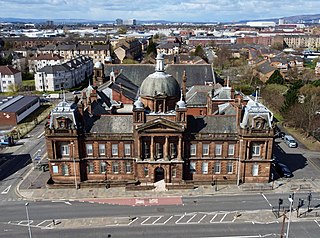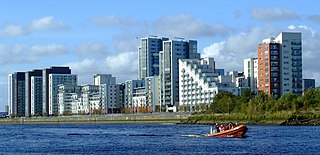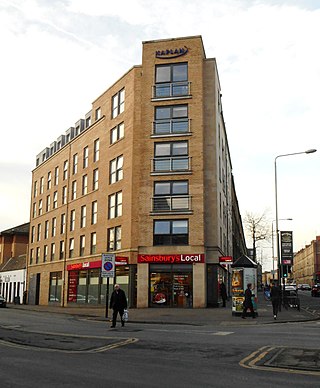
The River Clyde is a river that flows into the Firth of Clyde in Scotland. It is the ninth-longest river in the United Kingdom, and the third-longest in Scotland. It runs through the major city of Glasgow. Historically, it was important to the British Empire because of its role in shipbuilding and trade. To the Romans, it was Clota, and in the early medieval Cumbric language, it was known as Clud or Clut. It was central to the Kingdom of Strathclyde.

The Firth of Clyde is the mouth of the River Clyde. It is located on the west coast of Scotland and constitutes the deepest coastal waters in the British Isles. The firth is sheltered from the Atlantic Ocean by the Kintyre peninsula, which encloses the outer firth in Argyll and Ayrshire. The Kilbrannan Sound is a large arm of the Firth of Clyde, separating the Kintyre Peninsula from the Isle of Arran. Within the Firth of Clyde is another major island – the Isle of Bute. Given its strategic location at the entrance to the middle and upper Clyde, Bute played a vital naval military role during World War II.

Govan is a district, parish, and former burgh now part of south-west City of Glasgow, Scotland. It is situated 2.5 miles (4.0 km) west of Glasgow city centre, on the south bank of the River Clyde, opposite the mouth of the River Kelvin and the district of Partick. Historically it was part of the County of Lanark.

The Fairfield Shipbuilding and Engineering Company, Limited was a Scottish shipbuilding company in the Govan area on the Clyde in Glasgow. Fairfields, as it is often known, was a major warship builder, turning out many vessels for the Royal Navy and other navies through the First World War and the Second World War. It also built many transatlantic liners, including record-breaking ships for the Cunard Line and Canadian Pacific, such as the Blue Riband-winning sisters RMS Campania and RMS Lucania. At the other end of the scale, Fairfields built fast cross-channel mail steamers and ferries for locations around the world. These included ships for the Bosporus crossing in Istanbul and some of the early ships used by Thomas Cook for developing tourism on the River Nile.

The Finnieston Crane or Stobcross Crane is a disused giant cantilever crane in the centre of Glasgow, Scotland. It is no longer operational, but is retained as a symbol of the city's engineering heritage. The crane was used for loading cargo, in particular steam locomotives, onto ships to be exported around the world.

This article deals with the history of the city of Glasgow, Scotland. See also Timeline of Glasgow history.

John Brown and Company of Clydebank was a Scottish marine engineering and shipbuilding firm. It built many notable and world-famous ships including RMS Lusitania, RMS Aquitania, HMS Hood, HMS Repulse, RMS Queen Mary, RMS Queen Elizabeth and the Queen Elizabeth 2.

Glasgow Harbour in the following paragrphs is about a private sector urban regeneration scheme at Partick in the West End of the city of Glasgow, Scotland. It is not the history and development of the wider and internationally famous Glasgow Harbour from Glasgow Green to Clydebank which developed from the early 1800s and witnessed the birth and growth of modern shipbuilding and shipping.

The Glasgow Garden Festival was the third of the five national garden festivals, and the only one to take place in Scotland.

William Denny and Brothers Limited, often referred to simply as Denny, was a Scottish shipbuilding company.
Alexander Stephen and Sons Limited, often referred to simply as Alex Stephens or just Stephens, was a Scottish shipbuilding company based in Linthouse, Glasgow, on the River Clyde and, initially, on the east coast of Scotland.

The Clyde Arc is a road bridge spanning the River Clyde in Glasgow, Scotland, connecting Finnieston near the Clyde Auditorium and SEC with Pacific Quay and Glasgow Science Centre in Govan. Prominent features of the bridge are its innovative curved design, and that it crosses the river at an angle. The Arc is the first city centre traffic crossing over the river built since the Kingston Bridge was opened to traffic in 1970.
The General Terminus and Glasgow Harbour Railway was authorised on 3 July 1846 and it opened, in part, in December 1848.

The Riverside Museum is a museum in Glasgow, designed by Zaha Hadid Architects, housed in a building at Pointhouse Quay in the Glasgow Harbour regeneration district of Glasgow, Scotland. The building opened in June 2011, winning the 2013 European Museum of the Year Award. It houses many exhibits of national and international importance. The Govan-Partick Bridge will provide a pedestrian link from the museum across the Clyde to Govan. It is set to be completed in 2023.

The 20 km long Clyde Waterfront Regeneration, launched in 2003, embraced a section of the River Clyde in Scotland that runs from Glasgow Green in the city's center to Dumbarton down river. This scene focussed on earlier initiatives underway from the 1980s, and as a separate marketing tool, with several local authorities involved, came to an end in 2014.
Clyde Docks Preservation Initiative (CDPI) is a research, networking and advocacy social enterprise concerned with the protection and promotion of maritime heritage along the River and Firth of Clyde in the West of Scotland. The organisation works in partnership with diverse organisations to raise awareness of the issues impacting on the maritime heritage of the region.

James Deas was a 19th-century Scottish harbour engineer.

The disused Park Quay or Fulton's Quay is located on the old Lands of Park, situated on the south bank of the River Clyde in the Parish of Inchinnan, close to Newshot Island and the old Rashielee Quay. A slipway is also part of the infrastructure, giving access to the dock at low tide, both once served by roads running through the Park Estate from the south. It was recorded as Fulton's Quay in 1830, the name of a previous owner of the Park Estate who may have built it prior to 1801. A fixed light was installed at Park Quay in 1869.

The old Rashielee Quay or Rashielie Quay (NS471709) was located on the old Lands of North Barr, situated on the south bank of the River Clyde in the Parish of Inchinnan, between Bodinbo Island and Park Quay. It was built to facilitate the loading of boats and barges with whinstone excavated from the nearby Rashielee Quarries that was brought to the quay by a horse drawn wagonway.

Kelvinhaugh is a neighbourhood in the city of Glasgow, Scotland. It is situated directly north of the River Clyde in the West End of the city.


![The derelict Govan Graving Docks [de] complex. Govan Docks - geograph.org.uk - 1403329.jpg](http://upload.wikimedia.org/wikipedia/commons/thumb/1/14/Govan_Docks_-_geograph.org.uk_-_1403329.jpg/220px-Govan_Docks_-_geograph.org.uk_-_1403329.jpg)
















